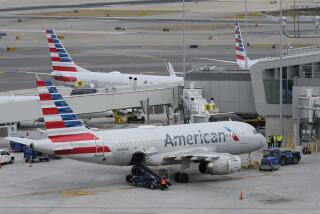American Flies Solo With Plan to Boost Its Fares : Analysts Skeptical of Move as Rivals Balk at Matching Increase Set for Sept. 29
- Share via
NEW YORK — American Airlines, which carries more passengers than any other U.S. air carrier, announced Wednesday that it will increase the fares paid by 42% of its customers.
However, no competing airlines immediately matched the increases, which are scheduled to go into effect Sept. 29, raising the possibility that American will have to cancel them.
The discount fares involved are designed for leisure travelers who can make their plans seven to 14 days in advance.
Most of the other major airlines, including United, Delta, USAir, Continental and Eastern, said they were studying American’s new fares. Normally, when competitors follow price action by one airline, they make the moves within a few hours.
On the other hand, if other airlines choose not to follow the leader, it is not unusual for announced fare increases to be canceled, because airlines must remain competitive on prices. Some industry observers maintain that fare increases and decreases are often just trial balloons.
For instance, Continental in midsummer tightened the restrictions on some of its discount fares. But other airlines did not follow suit, so Continental withdrew the changes.
Under American’s new fare schedule, the fares that are charged business travelers, who usually cannot make their reservations much in advance, will not be changed. These fares are significantly higher than the discount rates charged vacationers who reserve in advance.
Bad Time for Hikes
“I think it is unlikely that the industry will agree to a fare increase at this point in time,” said Edmund S. Greenslet, a Florida airline analyst who publishes the Airline Monitor. “Traffic is lousy. There is a lot of consumer resistance. It is just not the time to raise fares.”
Hans J. Plickert, an analyst with the New York-based Transportation Group, an affiliate of Paine Webber Inc., said: “It is going to be interesting to see if others follow suit. I think there will be less than universal acceptance. And with what is happening in Washington, I think it is a bad time to call attention to the airline industry by raising fares.”
Despite the concerns, American insisted Wednesday that it will implement its fare hikes. “We plan to put these fares into effect,” spokesman John Hotard said. “We’re trying to get the yields up.”
Congress is holding hearings on business concentration in the airline industry, and the Transportation Department has threatened to thwart some buyouts in the industry if it appears that heavy loads of debt are threatening the safe operation of an airline.
If American’s higher fares do indeed take effect at the end of next week, the cost of a trip of less than 1,000 miles--with a 14-day advance purchase--would rise $10 round trip. For journeys of more than 1,000 miles, the increase would be $20 round trip.
The 14-day, advance-reservation MaxSaver peak-time fare between Los Angeles and Dallas-Ft. Worth, for example, is $338 round trip. It would rise to $358.
These MaxSaver tickets would remain non-refundable.
American also plans to raise the price of its seven-day advance tickets--by $30 to $60 round trip. The price of a Dallas-Los Angeles round-trip ticket bought seven days in advance for a peak-time flight would increase to $438 from $378. The penalty for changing or canceling a seven-day advance reservation would double to 50% of the ticket price.
May Not Have Seats
Peak time is from noon Thursday to noon Monday. Many business travelers head home on Friday for the weekend and leave again Sunday night or Monday morning.
American says 35% of its passengers travel on 14-day advance purchase fares. An additional 7% get the higher, but still discounted, fares with seven-day advance-purchase requirements.
The airlines control the number of advance-purchase seats on each flight, and often no 14-day advance purchase seats are available on a particular flight.
According to Paul Karos, airline analyst with First Boston Corp., a New York brokerage house, American had 17.1% of the domestic airline market in August. United was second with 16.6%. The percentages reflect revenue passenger miles (the number of paying passengers multiplied by the number of miles flown).
Meanwhile, American on Wednesday also dedicated a $27-million terminal at its new Miami hub and announced that it had chosen Miami as its headquarters for serving the Caribbean and Latin America.
American had been negotiating to purchase the South American routes of bankrupt Eastern Airlines. However, no agreement was reached, and American decided to enlarge its own presence in the region.
AMERICAN’S NEW RATE SCHEDULE
OLD FARES
14-day advance 7-day advance Off-Peak Peak Off-Peak Peak Dallas-New York $278 $318 $338 $378 Dallas-Los Angeles 298 338 338 378 Dallas-Chicago 208 218 248 258 Chicago-Los Angeles 298 338 358 398 Chicago-New York 238 278 278 318
NEW FARES
(Sept. 29, 1989) 14-day advance 7-day advance Off-Peak Peak Off-Peak Peak Dallas-New York $298 $338 $378 $418 Dallas-Los Angeles 318 358 398 438 Dallas-Chicago 218 228 278 288 Chicago-Los Angeles 318 358 398 438 Chicago-New York 248 288 308 348
Note: All rates are round trip.
Source: American Airlines
More to Read
Inside the business of entertainment
The Wide Shot brings you news, analysis and insights on everything from streaming wars to production — and what it all means for the future.
You may occasionally receive promotional content from the Los Angeles Times.










